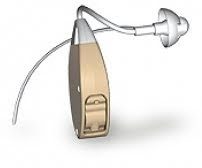People who suffer from some form of hearing loss have a number of different types and styles of Hearing Aid to choose from. Depending on the amount of hearing loss, could affect the type of Aid most suitable.
A number of hearing impaired people are put off wearing a Hearing Aid because of vanity, thinking only what it will look like having a bulky Aid in full view behind the ear. However, there have been vast improvements in Hearing Aids over the last few years including many that can hardly be seen.
Because of development of Digital, Hearing Aids are now being made much smaller and more effective than the Analogue Hearing Aids of the past.
There are a number of different configurations of Digital Aids designed to meet the needs of nearly all hearing loss sufferers. Behind the ear (BTE) are the most common type and have been around almost since the first Hearing Aids were developed. The main part of the Aid fits behind the outer ear and contains the microphone, amplifier and speaker. A thin clear tube is connected from this to an ear mould that fits into the ear channel and delivers sound into the ear.
This type is generally more powerful than other types of Hearing Aid because of its size and is most useful for sufferers with severe or profound losses. It is also most suitable for children as the ear mould can be easily changed as the child grows up instead of having to renew the complete Hearing Aid.
In the Ear (ITE) Hearing Aids sit in the outer ear and contain all the working parts within the ear mould. They can fit a wide range of patients including mild to profound hearing losses. It fills the entire centre of the ear and therefore it is not possible to hide this type of Hearing Aid. The microphone is much closer to the ear drum, than the BTE type, giving increased sound reception. It is usually less expensive and has a longer battery life.
In the Channel (ITC) Hearing Aids are specifically moulded to fit within the ear channel and are suitable for sufferers with mild hearing loss. They are still visible but much less so than the (ITE) type. They are found to be much more costly than the ITE type as they are smaller therefore more difficult to build. The battery life is also shorter than the ITE type as it has to be much smaller.
The Completely in the Channel (CIC) Hearing Aids are similar to the ITC type and is only effective for people with mild to moderate hearing. It is very much smaller than any other type of Hearing Aid as it has to completely fit inside the ear channel. They are almost invisible when worn and need to be very carefully inserted and removed. The CIC Hearing Aid has many advantages especially if you do not want others to know you are wearing it. It is usually much more costly and the batteries do not last very long due to its very small size.
The Body worn Hearing Aid is ideal for sufferers of profound hearing loss. It is made up of an earpiece, the loudspeaker, which is placed on the ear and connected by an electrical wire to a small box attached to the clothing or placed in a pocket. Because of its size it can be very powerful and usually easy to control. This type of Aid is not very expensive as the components do not have to be made very small.
Choosing the right type of Hearing Aid for your particular hearing loss and comfort should not be made quickly. The amount of hearing loss and if you want it to be unseen are just two of the major considerations.
Friday, 8 January 2010
Subscribe to:
Post Comments (Atom)

Certainly there are various types of hearing aids are available in the market. You can take the help of your hearing aid audiologist to choose the best one for you or you can do your own research.
ReplyDeleteRegards,
hearingaids
It depends on which type of hearing loss you have and to which extent the hearing ability is damaged.
ReplyDeletehttp://www.novoushearing.com